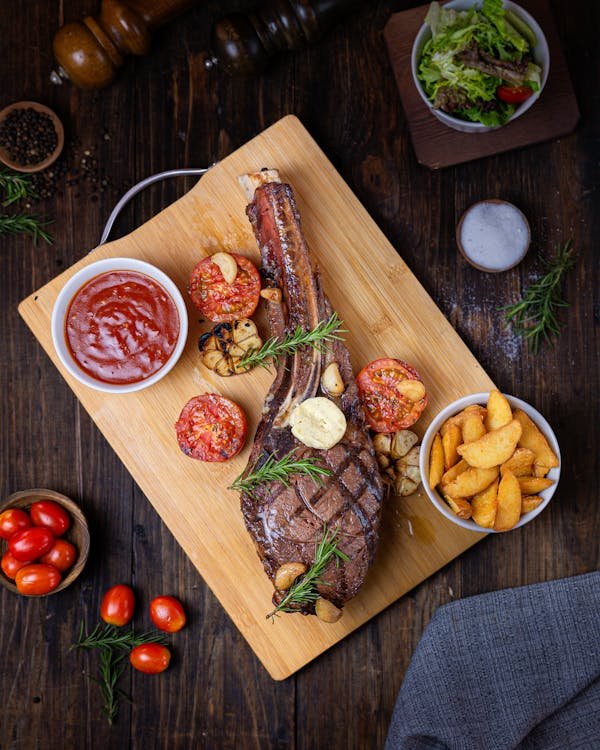
Cooking the perfect steak is an art, but even the most experienced cooks know that getting the internal temperature just right can be tricky. A meat thermometer is the best tool for ensuring that your steak is cooked to perfection, whether you like it rare, medium, or well-done. In this guide, I’ll explain everything you need to know about using a meat thermometer for steaks, based on expert advice and years of experience.
Why You Need a Meat Thermometer
A meat thermometer takes the guesswork out of cooking steaks. It ensures that your meat is cooked to the exact temperature you want, preventing undercooked or overcooked steaks. Whether you’re grilling, pan-searing, or broiling, the internal temperature is the key to a steak that’s juicy, flavorful, and safe to eat.
Types of Meat Thermometers
There are several types of meat thermometers available, each with its own advantages. Here’s a quick rundown of the most common ones:
- Digital Instant-Read Thermometers: These are quick, accurate, and ideal for checking steak temperatures quickly.
- Dial Thermometers: Traditional and reliable but slower to provide a reading.
- Wireless Meat Thermometers: Allow you to monitor the temperature remotely, giving you the freedom to walk away from the grill.
- Probe Thermometers: These are left in the meat during cooking, constantly measuring the internal temperature.
How to Properly Use a Meat Thermometer
Using a meat thermometer is simple, but there are a few key steps to follow to ensure accuracy:
- Insert the Thermometer Correctly: Insert the thermometer through the thickest part of the steak, ensuring it’s not touching bone or fat. For best results, insert it horizontally into the side of the steak, especially with thinner cuts.
- Wait for a Stable Reading: For instant-read thermometers, wait a few seconds until the temperature stabilizes. With dial thermometers, this may take longer.
- Remove the Steak Slightly Below Target Temperature: Steaks will continue to cook for a minute or two after being removed from heat. Aim to pull them off the grill when they are 5°F below your desired temperature.
Recommended Temperatures for Steak Doneness
Achieving the perfect steak doneness requires knowing the right internal temperature. Here’s a handy reference:
- Rare: 120°F to 125°F (Red, cool center)
- Medium Rare: 130°F to 135°F (Warm red center)
- Medium: 140°F to 145°F (Pink, warm center)
- Medium Well: 150°F to 155°F (Slightly pink center)
- Well Done: 160°F and above (Little to no pink)
Avoiding Common Mistakes
While using a meat thermometer is straightforward, there are a few common mistakes to avoid:
- Not Calibrating Your Thermometer: Always calibrate your thermometer regularly to ensure accuracy. You can do this by inserting it into ice water (should read 32°F) or boiling water (should read 212°F).
- Measuring in the Wrong Spot: Don’t measure near the bone or fat, as these areas can give inaccurate readings.
- Not Cleaning the Thermometer Between Uses: Always clean your thermometer after checking the temperature to avoid cross-contamination.
Step-by-Step Guide to Using a Meat Thermometer for Steaks
- Preheat the Grill or Pan: Ensure your cooking surface is at the right temperature before placing the steak on it.
- Sear the Steak: This helps lock in the juices. If you’re cooking on the grill, sear each side for 2-3 minutes.
- Insert the Thermometer: After searing, insert the thermometer horizontally into the thickest part of the steak.
- Monitor the Temperature: For rare steaks, aim for around 120°F. For medium-rare, look for 130°F.
- Remove Steak and Let it Rest: Once the steak reaches the desired temperature, remove it from the heat. Let it rest for 5 minutes before serving.
Using a Meat Thermometer for Burgers
While steaks are the primary focus of this article, you can use the same techniques for burgers. Ensuring the right internal temperature is essential for food safety with ground meat.
- Well Done Burgers: 160°F is the safe internal temperature to kill harmful bacteria.
Pros and Cons of Using a Meat Thermometer
Here’s a quick look at the advantages and drawbacks of using a meat thermometer:
| Pros | Cons |
|---|---|
| Ensures perfect doneness every time | Requires calibration for accurate readings |
| Reduces the risk of undercooking or overcooking | Extra step in the cooking process |
| Helps maintain food safety | May need replacement batteries (digital) |
| Useful for different types of meat | May not be necessary for experienced cooks |
| Affordable and widely available | Some models can be expensive |
| Easy to use for beginners | Can slow down the cooking process |
FAQs About Using a Meat Thermometer
Conclusion
Using a meat thermometer is the most reliable way to cook perfect steaks every time. It ensures you hit the exact temperature for the doneness you prefer while maintaining safety and flavor. From rare to well-done, a good meat thermometer will help you master the art of steak cooking like a pro.